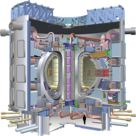Mobile robot fault-tolerant navigation in nuclear fusion scenarios of ITER

- Supervisor: Prof. Rodrigo Ventura
- Co-Supervisor: Doutor Alberto Vale
Framework
ITER-International Thermonuclear Experimental reactor is a joint international research and development project that aims to demonstrate the scientific and technical feasibility of fusion power (a safety source of energy with abundant fuel resources, to meet the needs of a growing world population). The ITER reactor is installed on a building (the Tokamak building) with dimensions equivalent to a football field and where the human beings are not allowed as soon as the operation starts. A Transfer Cask System (TCS) for the transportation of components during maintenance operations is required.
The TCS consists of an unshielded (with respect to gamma radiation) mobile vehicle with dimensions similar to an autobus with a maximum load of 100T and moved by air-cushion, provided with autonomous guidance and docking. This TCS must be able to travel between different pre-defined start/goals locations in different levels of the Tokamak building.
Objectives
A navigation system for the TCS vehicle to regain contact with a pre-defined path, once it gets off track.
Description
The guidance of the TCS vehicle is primarily based on following electrical wires grounded on the floor. These wires carry an electrical current, whose magnetic field is measured by electromagnetic sensors onboard the vehicle, close to the steering motors. The vehicle is guided by the measured deviation from these wires, thus following the path defined by them. However, it is necessary to localize the vehicle at all times, not only for redundancy, but also in the event of the vehicle getting off-track. This thesis addresses the problem of recovering from the off-track situation, i.e., recovering the trajectory by both wheels. In this case, it is necessary for the vehicle to be able to re-capture the path defined by the wiring network. Taking into account the inertia of the vehicle and the environment constraints, it is a non-trivial problem to navigate the vehicle in such a way it can safely regain contact with the track, taking into account the tight free space of the plant. Given the quasi-holonomic kinematics of the robot, there are several solutions to do this. Moreover, different control strategies are needed when both wheels are off-track, or when one of them is. The vehicle is assumed to be localized in the plant.
Related links
- Further information on RH in ITER: http://www.ipfn.ist.utl.pt/rh
- ITER - http://www.iter.org